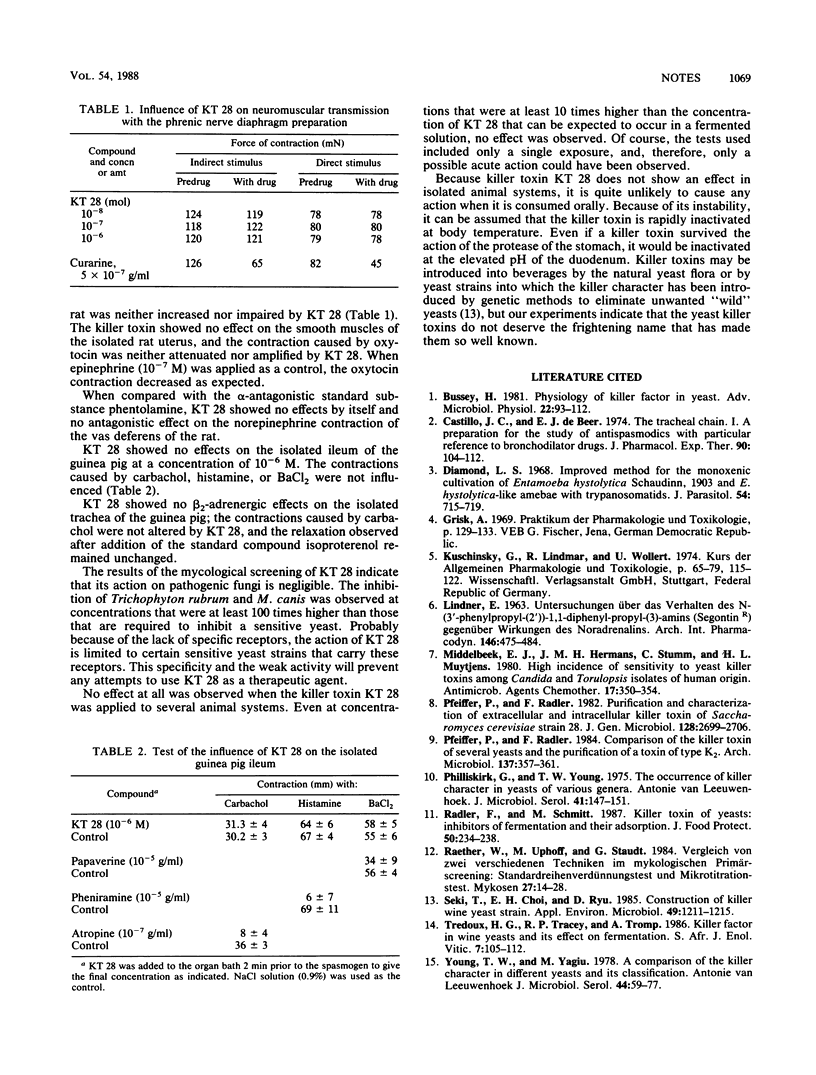Abstract
The Saccharomyces cerevisiae killer toxin KT 28, which inhibits sensitive yeasts, was shown to have no effect on several pathogenic fungi or on the protozoan Trichomonas vaginalis. At concentrations of about 0.1 mg/ml, a partial inhibition of the skin pathogenic fungi Trichophyton rubrum and Microsporum canis was observed at pH 6.5. No pharmacological activity was detected in various tests with several animal organs.
Full text
PDF

Selected References
These references are in PubMed. This may not be the complete list of references from this article.
- Bussey H. Physiology of killer factor in yeast. Adv Microb Physiol. 1981;22:93–122. doi: 10.1016/s0065-2911(08)60326-4. [DOI] [PubMed] [Google Scholar]
- Diamond L. S. Improved method for the monoxenic cultivation of Entamoeba histolytica Schaudinn, 1903 and E. histolytica-like amebae with trypanosomatids. J Parasitol. 1968 Aug;54(4):715–719. [PubMed] [Google Scholar]
- LINDNER E. UNTERSUCHUNGEN UEBER DAS VERHALTEN DES N-(3'-PHENYL-PROPYL-(2'))-1,1-DIPHENYL-PROPYL-(3)-AMINS (SEGONTIN (1)) GEGENUEBER WIRKUNGEN DES NORADRENALINS. Arch Int Pharmacodyn Ther. 1963 Dec 1;146:475–484. [PubMed] [Google Scholar]
- Middelbeek E. J., Hermans J. M., Stumm C., Muytjens H. L. High incidence of sensitivity to yeast killer toxins among Candida and Torulopsis isolates of human origin. Antimicrob Agents Chemother. 1980 Mar;17(3):350–354. doi: 10.1128/aac.17.3.350. [DOI] [PMC free article] [PubMed] [Google Scholar]
- Pfeiffer P., Radler F. Comparison of the killer toxin of several yeasts and the purification of a toxin of type K2. Arch Microbiol. 1984 Apr;137(4):357–361. doi: 10.1007/BF00410734. [DOI] [PubMed] [Google Scholar]
- Philliskirk G., Young T. W. The occurrence of killer character in yeasts of various genera. Antonie Van Leeuwenhoek. 1975;41(2):147–151. doi: 10.1007/BF02565046. [DOI] [PubMed] [Google Scholar]
- Raether W., Uphoff M., Staudt G. Vergleich von zwei verschiedenen Techniken im mykologischen Primärscreening: Standardreihenverdünnungstest und Mikrotitrationstest. Mykosen. 1984 Jan;27(1):14–28. [PubMed] [Google Scholar]
- Seki T., Choi E. H., Ryu D. Construction of killer wine yeast strain. Appl Environ Microbiol. 1985 May;49(5):1211–1215. doi: 10.1128/aem.49.5.1211-1215.1985. [DOI] [PMC free article] [PubMed] [Google Scholar]
- Young T. W., Yagiu M. A comparison of the killer character in different yeasts and its classification. Antonie Van Leeuwenhoek. 1978;44(1):59–77. doi: 10.1007/BF00400077. [DOI] [PubMed] [Google Scholar]


